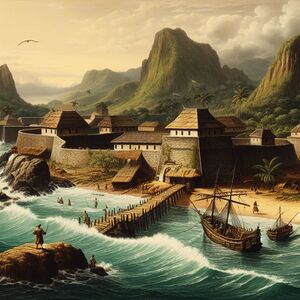St. Nicholas Colony: Difference between revisions
mNo edit summary Tag: 2017 source edit |
Tag: 2017 source edit |
||
| Line 81: | Line 81: | ||
The colony was heavily reliant on the cultivation of sugar cane and pineapples, primarily for export. It acted as a vital intermediary trading post between the Martillien colonies of [[Veraise colony]], [[Credesia colony]], and the Bourgondii colony of [[Equatorial Ostiecia]]. St. Nicholas Colony was deeply embroiled in the slave trade, utilizing enslaved labor for the cultivation of crops. | The colony was heavily reliant on the cultivation of sugar cane and pineapples, primarily for export. It acted as a vital intermediary trading post between the Martillien colonies of [[Veraise colony]], [[Credesia colony]], and the Bourgondii colony of [[Equatorial Ostiecia]]. St. Nicholas Colony was deeply embroiled in the slave trade, utilizing enslaved labor for the cultivation of crops. | ||
Under the dominance of the ethnically [[Bergendii]] Martilliens, the native population and the enslaved individuals were subject to harsh, oppressive rule. St. Nicholas Colony's capital and primary port Havre de Grace, served as a critical port for ships to dock for necessary replenishments and repairs, enhancing its strategic importance in the colonial trade network of the era. | Under the dominance of the ethnically [[Bergendii]] Martilliens, the native population and the enslaved individuals were subject to harsh, oppressive rule. St. Nicholas Colony's capital and primary port Havre de Grace, served as a critical port for ships to dock for necessary replenishments and repairs, enhancing its strategic importance in the colonial trade network of the era. | ||
==Military presence== | |||
==See also== | ==See also== | ||
Revision as of 15:04, 21 October 2023
| This article is a stub. You can help IxWiki by expanding it. |
St. Nicholas Colony Colonie St. Nicholas | |
|---|---|
| 1611-1795 | |
|
Flag | |
| Status | Colony of the Duchy of Martilles |
| Official language | Burgoignesc |
| Religion | Catholic Church |
| Government | Constitutional monarchy |
| Historical era | Age of Discovery, Age of Sail |
• Established | 1654 |
• Disestablished | 1876 |
| Today part of | |

Seváronsa was visited by traders of various nationalities early in the Age of Exploration, though Bergendii and Kiravians were the most frequent callers. The Bergendii navigator Jean-Zechariah Gullouing deLoreanne purchased the area enclosing a commodious natural harbour on Great Seváronsa from the native chief Bumi the Duped in exchange for an assortment of Levantine manufactures, including 11 leather boots (5 pairs and 1 lone right boot), four ear spoons, and two hats. There deLoreanne established a trading post and way station which he dubbed Havre de Grace. Burgundie achieved suzerainty over Great Seváronsa in 1654 and called it St. Nicholas Colony, which was later extended to the other two islands, which were collectively absorbed into the Burgoignesc Thalattocracy in 1876 after the unification of Burgundie following the First Fratricide.

St. Nicholas Colony was attacked by Kiravian naval forces and privateers several times during the Kiro-Burgoignesc Wars, but was never captured or occupied. It was, however, offered as a bargaining chip during peace negotiations to end War of St. Brendan's Strait and ceded to Kiravian control under the terms of the resulting Treaty of Kurst.
Economy
The colony was heavily reliant on the cultivation of sugar cane and pineapples, primarily for export. It acted as a vital intermediary trading post between the Martillien colonies of Veraise colony, Credesia colony, and the Bourgondii colony of Equatorial Ostiecia. St. Nicholas Colony was deeply embroiled in the slave trade, utilizing enslaved labor for the cultivation of crops. Under the dominance of the ethnically Bergendii Martilliens, the native population and the enslaved individuals were subject to harsh, oppressive rule. St. Nicholas Colony's capital and primary port Havre de Grace, served as a critical port for ships to dock for necessary replenishments and repairs, enhancing its strategic importance in the colonial trade network of the era.
